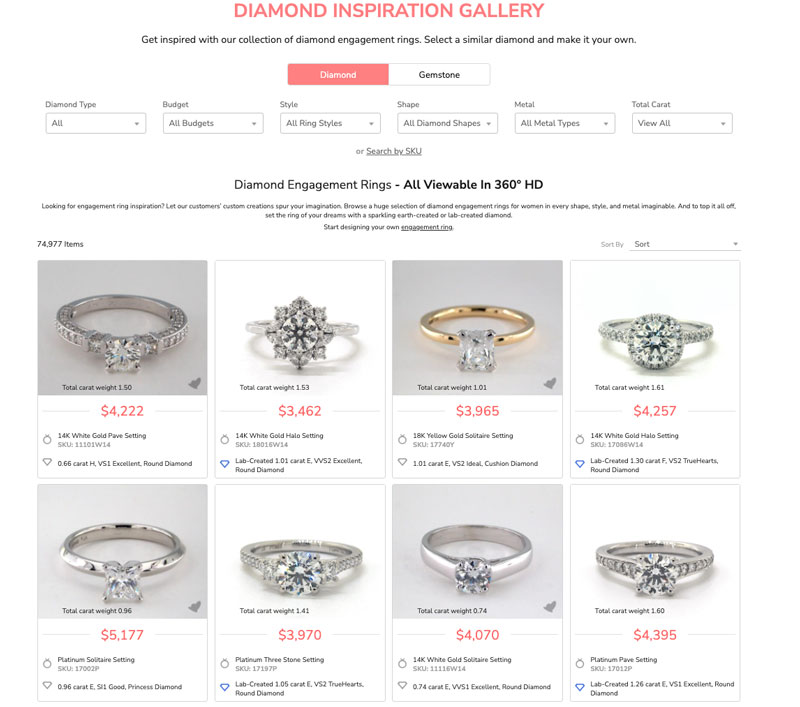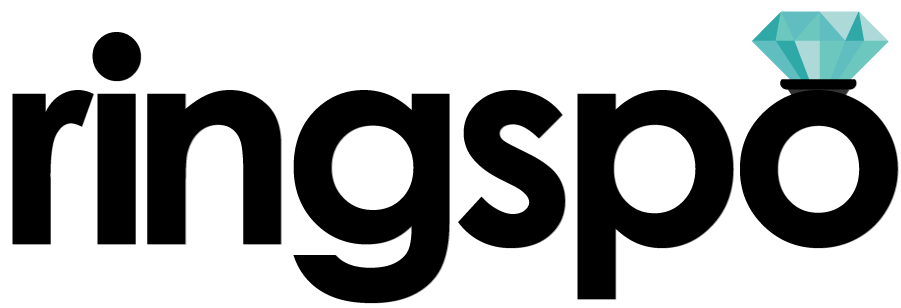Platinum engagement rings
Quality and class
Ringspo is reader supported
Ringspo is reader-supported, which means we may receive a commission if you click a link to a retailer & subsequently make a purchase.
We feature links to several retailers to help readers find the one that is the best fit for them. Find out more about how Ringspo works here.
Platinum is the rarest metal that is commonly used to make engagement rings, but it’s also one of the most popular – its mix of beauty and durability is a great metaphor for marriage.
In this section we’ll look at:
- Where platinum came from and why it’s used in engagement rings
- A little bit of technical info about platinum, so you know what it is that you’re buying
- What’s good about platinum engagement rings
- What’s not so good
- A selection of platinum rings for you to check out.
At the end you should have everything you need to know to make an informed choice about platinum engagement rings, as well as some inspiration for choosing your ring.
Not sure which color to get?
If you’re a guy and you’re not sure whether to get a white-colored or a yellow gold engagement ring, the easiest way to tell is to check out your better half’s jewelry box.
If the majority of the jewelry is yellow gold, then stick with it. But, if the majority of her jewelry is silver or white gold, then consider white gold or platinum for your ring.
A bit of background
Platinum has been known about for hundreds of years, but wasn’t widely used in jewelry design until the 18th Century, when Louis XVI of France took a bit of a, er, shine to it.
Platinum is a difficult metal to work with though, so its popularity wasn’t widespread until the 20th Century. It has a much higher melting point than gold, which means that heating it up to a point where it is malleable and can be fashioned into jewlery is more difficult.
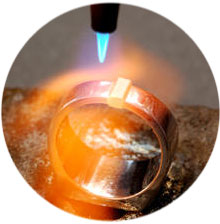
It wasn’t until the invention of the oxy-acetylene torch in 1901 that it became easy for jewelers to heat platinum to the required temperature.
Platinum rings were extremely popular in the first half of the 20th century as jewelers realized that they could make extremely delicate and intricate shapes with platinum but retain durability. Then in WWII platinum was placed on the ‘strategic metals’, so it was prohibited from being used for jewelry. White gold was used instead, and platinum didn’t become popular again until the ‘80s.
Today it’s still a distant second to white gold in the popularity stakes, but for those who can afford it, platinum offers some big advantages over white gold. Because the decision on whether to go with platinum for your engagement ring setting is basically whether you choose it or choose white gold, the majority of his post is going to be comparing the two.
What is platinum?
Platinum is a chemical element that is mainly found and mined in South Africa, with some produced in Russia too. When it’s dug out of the ground, it looks a little bit like the nugget below.

The majority of it is used for industrial use, like catalytic convertors in cars, but a small percentage of it is used for jewelry.
The platinum that’s used in jewelry isn’t 100% pure, but it isn’t far off, unlike other precious metals when they’re used in jewelry. While gold used in jewelry is 75% pure at best, or possibly only 37.5% pure for 9 carat gold, jewelry-grade platinum is usually 95% pure.
Platinum is mixed with other metals to give it strength – without another metal present it would bend extremely easily.
In the US, any items labelled ‘platinum’ must be at least 95% platinum weight. If a metal is less than 95% platinum will be labelled with the other metal first e.g. COB/PLAT indicates that the metal is 10% cobalt and 90% platinum. So, if you’re looking at a ring that is described as ‘platinum’, you can be sure that it is 95% pure.
Platinum labelling works like this:
- PT950 is 95% platinum by weight
- PT900 is 90% platinum by weight
- PT850 is 85% platinum by weight

There are a few metals that are commonly used to create platinum alloys, and each has different properties:
- Iridium – the most common metal used, but it makes platinum allows that are softer than the alternatives and most likely to lose its lustre. However, it can be worked into the finest designs.
- Ruthenium – the most durable with a shiny finish
- Cobalt – generally considered to be the highest quality with the brightest finish
What’s good about platinum engagement rings?
Platinum diamond rings are durable
Aside from its beauty, one of the best things about platinum engagement rings is their durability. As the platinum used in jewelry is nearly 100% pure, you get all of the best properties of platinum, as well as the properties of the metal that it’s alloyed with.
So, while white gold engagement rings need to be replated every couple of years with the rhodium that covers them and keeps them white, platinum won’t lose its color, won’t tarnish and won’t need to be taken into a jeweler for a repair regularly.
Platinum rings are also much more resistant to damage from chemicals than gold rings, which can need to have care taken around cleaning liquids etc. That felt a bit sexist referring back to cleaning fluids, but it is something that needs to be considered by anyone (male or female!) who is wearing a ring.
Platinum ring settings are durable
The prongs that hold a diamond are extremely thin, and if they’re bent out of position your diamond could become loose or even fall out of your ring. This is an especially big issue for settings that have many small stones e.g. halo or pavé settings, where the tiny prongs that hold each individual diamond in place are particularly vulnerable.
Platinum is much stronger than gold, which means that it is less likely to be damaged or bent and will hold your diamond much more securely.
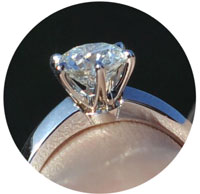
Platinum is Hypoallergenic
Platinum is hypoallergenic, which means that even people with sensitive skin can wear platinum engagement rings with no issues. About 10% of people are allergic to the nickel which is used in the alloy for white gold engagement rings, but for platinum this isn’t an issue.
Platinum Complements All Precious Stones
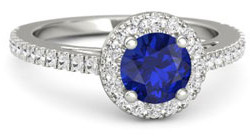
Platinum’s neutral white complements diamonds that are at the upper end of the color scale extremely well. It will refect the brilliance of the stone and show them off in their best possible light.
Platinum also looks great with other colored gems too though – whether it’s ruby, emerald or sapphire, platinum will present itself in the best possible light.
Platinum Delivers A Feeling of Solidity
Lastly, platinum is 4 times more dense than gold, so feels much more solid and weighty. Many people like this feel of ‘heft’ as it gives a luxurious feel.
What’s not so good about platinum engagement rings?
Platinum is significantly more expensive than white gold
The most obvious difference between platinum and white gold is the price. Although the price of platinum has come down in recent years, the raw material is about 30 times rarer than gold, and rarity inevitably results in an increased price.
Actually getting platinum out of the ground is much more difficult than gold too. There are far fewer platinum mines than gold mines around the world – for every 10 gold mines, there is just one platinum mine. And while 3-4 tons of ore need to be removed for each ounce of gold, 10 tons of platinum raw rock need to be mined for each ounce of platinum.
Added to this, platinum engagement rings use a much higher percentage of platinum than gold rings, so as well as using a more expensive metal, more of it is used. And lastly, platinum is more difficult to work with. It has a much higher melting point and is more difficult to bend and hammer than gold, so the workmanship costs are higher.
All of these points contribute to making platinum more expensive than white gold. And the bigger and blingier the setting you choose, the more platinum will be needed, which means that the difference in price is greater.

Solitaire engagement ring setting
Platinum: $1,100
18k white gold: $850
14k white gold: $600
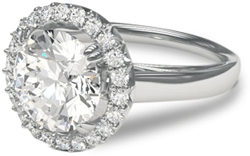
Halo engagement ring setting
Platinum:$2,400
18k white gold: $1,950
14k white gold: $1,680
Platinum can show scratches more readily
Although platinum is stronger than god, it actually scratches more easily.
There are two properties that are important for the durability of an engagement ring – strength and hardness. Platinum is stronger than gold, which means that your stone will be held more securely. But hardness is a measure of how easily something can be scratched and on this measure, the platinum used in jewelry scores lower than gold.
In its pure form, gold is much less hard than platinum, but because there is a large percentage of other, harder metals used in gold jewelry alloys, gold jewelry is actually harder than platinum jewelry.
What this means is that if you choose a platinum engagement ring, you should also make sure that your wedding ring is platinum so tat the two rings are the same hardness and one doesn’t wear the other away.
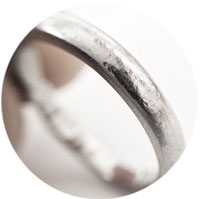
Platinum engagement ring settings
While it’s important to get the best center stone that you can for you ring, it’s the ring setting that really defines the character of the ring.
This list below is by no means definitive, but it’s a representation of some of the different styles of settings that are available. If you see a setting you like, click through to find out more and check out the other platinum setting styles that each jeweler offers too.
The classic solitaire is the best selling engagement ring by far, year after year. Its combination of elegant design and low cost due to simplicity is hard to beat.
It’s also the style that lets the most light possible enter the diamond, which means that it can sparkle as brightly as possible.
Check out platinum solitaire engagement rings here


A popular variation on the solitaire setting is the 6 prong solitaire, which is sometimes called the ‘Tiffany setting’ as it was originally designed by Tiffany & Co. in 1886.
With 6 prongs rather than 4, it will hold your diamond more securely, while still allowing just as much light in to ensure that it sparkles as much as possible.
See this ring and other options here
Bezel engagement rings are a smart choice for people with an active lifestyle who don’t want to have to worry about their ring getting damaged. The rim of metal around the edge of the diamond protects the delicate ‘girdle’ of the stone from getting damaged.
As well as great protection, the simple design means that bezel engagement rings are very competitively priced too.
Click here to check out platinum bezel engagement ring options

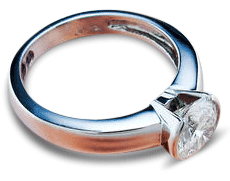
A small issue with the full bezel setting is that it restricts the amount of light that can enter the side of the diamond, which means that the stone sparkles slightly less than it potentially could.
This half bezel setting has a protective rim around the majority of the diamond, but leaves the sides open so that more light can enter the stone, meaning that it will sparkle more.
See more bezel and half-bezel platinum rings here

Adding detailing to the ring band can be a great way to make it ring stand out, without adding too much cost. This emerald-cut diamond engagement ring has a fine ‘millgrain’ effect on the band, which gives it a vintage feel.
See this and other vintage-inspired platinum engagement rings here
Other variations include the ‘infinity knot’, as shown on this ring with a cushion cut diamond. The ring band has been twisted into a figure of 8 on each side of the diamond, mimicking the infinity symbol as a subtle reminder of the commitment that the ring signifies.
Click here to see this and other ‘split shank’ platinum engagement rings
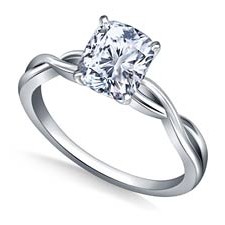
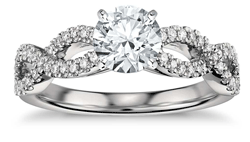
Adding a pavé effect (the tiny diamonds place on the band) can be a great way of increasing the impressiveness of a ring without the large jump in price that a larger center stone would bring. This example has an extra 0.25 carats of diamonds set into the ring band.
Check out more info on this ring and other pavé split shank diamond rings here
Platinum’s use in jewelry really look off at the turn of the 20th century and this vintage-inspired design takes many design cues from the ‘Art Nouveau’ fashions of the time. As well as millgrain detailing and channel-set diamonds in the band (adding 0.35 carats to the ring), the ring features a subtle bezel around the diamond to keep it safe while leaving the bottom of the stone uncovered, to ensure that it sparkle as much as possible.
See this ring and other vintage-inspired diamond rings here


Going from vintage-inspired to ultra modern, this ring puts an up-to-date twist on the bezel format, with an interesting and clean design.
Click here for more info on this ring
Tension rings are probably the most modern setting of all. Lasers are used to measure and precision-cut slots in the side of the ring to hold the diamond. Despite looking precarious, tension settings hold the center diamond extremely securely.
Check out platinum tension engagement ring choices here
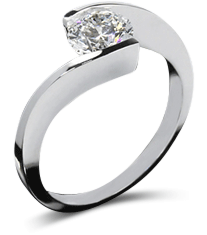

Variations on the standard solitaire format can make an engagement ring much more striking, as this split shank pavé setting shows. With 0.24 carats of diamond set on the ring band, this ring is a great modern twist on the oval solitaire engagement ring.
See more info on this ring and other split shank pavé engagement rings here
Halo settings are a great way to make an engagement ring look more impressive, even if the center stone isn’t particularly large. This ring has a cushion-cut center diamond, which offer incredible sparkle and great value.
Click here to check out platinum halo engagement rings
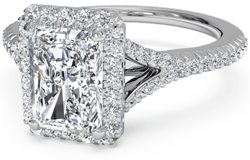

Supporting stones and pavé diamonds don’t need to be restricted to the top of the halo setting. This ring is covered in diamonds, on both the top and sides of the band and the top and sides of the halo setting, meaning that it will offer incredible sparkle no matter which angle it’s viewed from.
Such an elaborate arrangement does increase the cost of the setting, but it also doesn’t need a large center stone to be extremely impressive.
See more info on this ring and other Princess cut halo diamond rings here
The supporting stones on halo settings don’t necessarily need to do diamonds, as this ring shows. Using colored stones like sapphires, rubies or emeralds gives a great contrast to the diamond and makes a ring a really individual choice.
Check out this ring and other sapphire halo diamond rings here

With a great combination of beauty and strength, it’s obvious why platinum is a popular choice for engagement jewelry. It’s the most expensive metal used in engagement rings and for this reason alone it comes with a huge amount of prestige. Ultimately, an investment in platinum an be viewed as an investment in a future family heirloom
A great place to get inspiration for platinum diamond rings is online galleries which show a wide selection of recently purchased rings. You can use the dropdown menu to select just platinum rings and see what other people have been buying – definitely worth a look!
